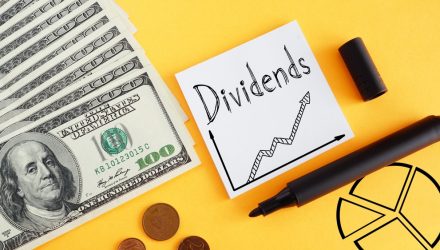Dividend stocks and exchange traded funds aren’t performing perfectly this year, but many are outperforming the broader market, confirming the long-coveted shelter-from-the-storm status of these assets.
Investors looking to get in on the act have an assortment of ETFs to evaluate, with the VanEck Morningstar Durable Dividend ETF (DURA) meriting a place in the conversation. Indeed, DURA’s year-to-date loss isn’t even half as bad as that of the S&P 500.
That benefit arrives with a dividend yield of 3.35%, meaning that the VanEck ETF’s yield is 170 basis points in excess of the S&P 500. DURA also holds significant appeal for younger investors that have the advantage and don’t need to access the income the ETF provides right away.
“Dividends, when reinvested, can significantly boost total returns over time, making dividend-paying stocks an attractive option for older and younger investors alike,” according to Charles Schwab research. “For example, if you invested $1,000 in a hypothetical investment that tracked the S&P 500® Index on January 1, 1990, but didn’t reinvest the dividends, your investment would have been worth $11,687 as of September 2022. If you had reinvested the dividends, you would have ended up with just over $20,000—nearly double.”
Obviously, the potency of dividend reinvestment is enhanced by exercising patience. That’s made easier with the benefit of dividend growth, which is occurring this year with S&P 500 payouts eclipsing records. Of course, equity income investors must realize that payout growth isn’t uniform across sectors, which is to say that some sectors offer better dividend growth than others. Some of the best on that front include healthcare, technology, and consumers staples. Those groups combine for almost two-thirds of DURA’s roster.
“Generally speaking, you want to find companies that not only pay steady dividends but also increase them at regular intervals—say, once per year over the past three, five, or even 10 years. Indeed, companies that grow their dividends tend to outperform their peers over time,” added Schwab. “Over the past 40 years, stocks that maintained or grew their dividends outperformed those that cut their payouts or offered none at all.”
While DURA’s underlying index looks for high dividend stocks, the fund’s exposure to names fitting the strictest definition of the term is relatively benign, indicating that the ETF is a more of an avenue for dividend growth than negative payout action.
For more news, information, and strategy, visit the Beyond Basic Beta Channel.
The opinions and forecasts expressed herein are solely those of Tom Lydon, and may not actually come to pass. Information on this site should not be used or construed as an offer to sell, a solicitation of an offer to buy, or a recommendation for any product.







